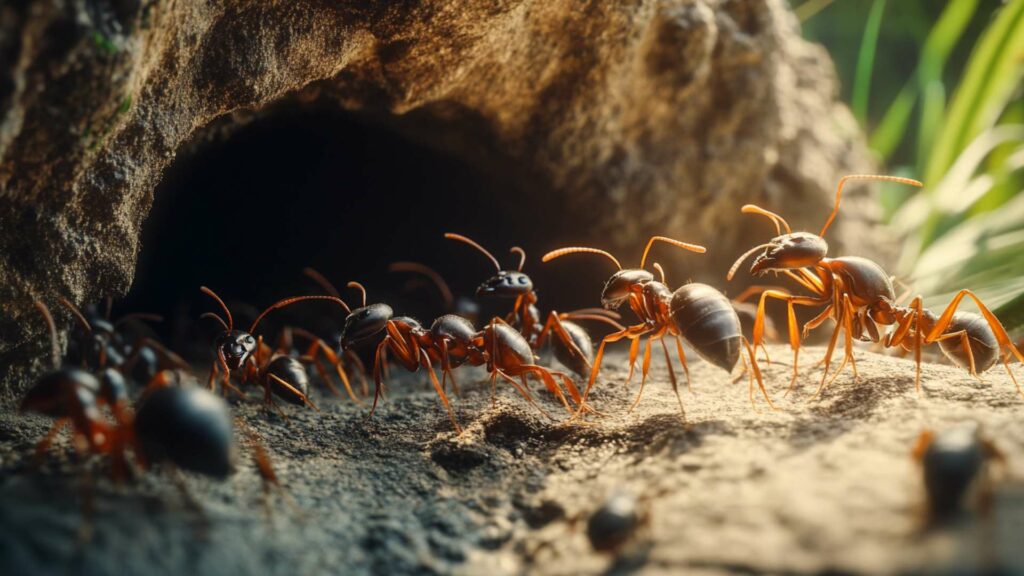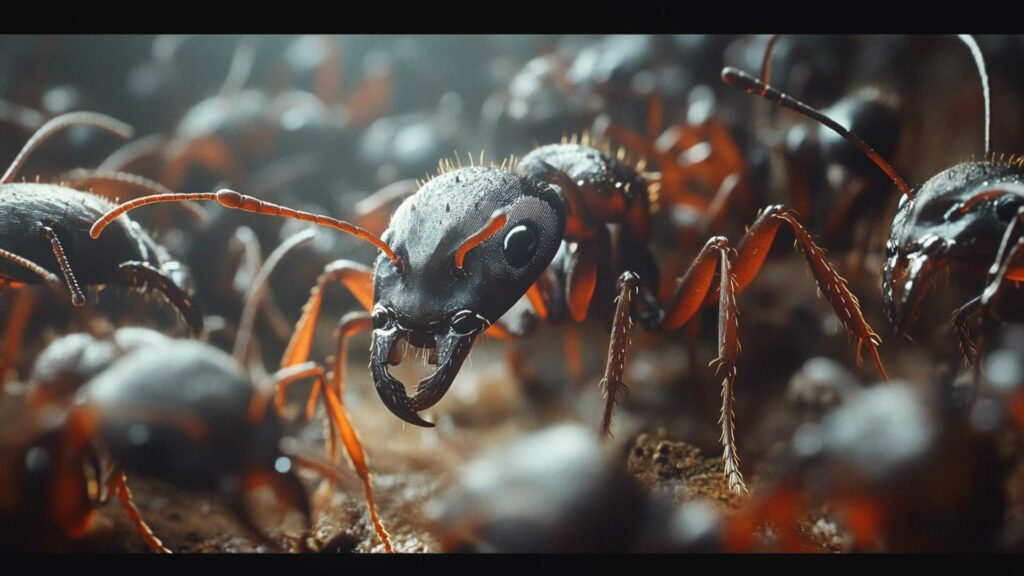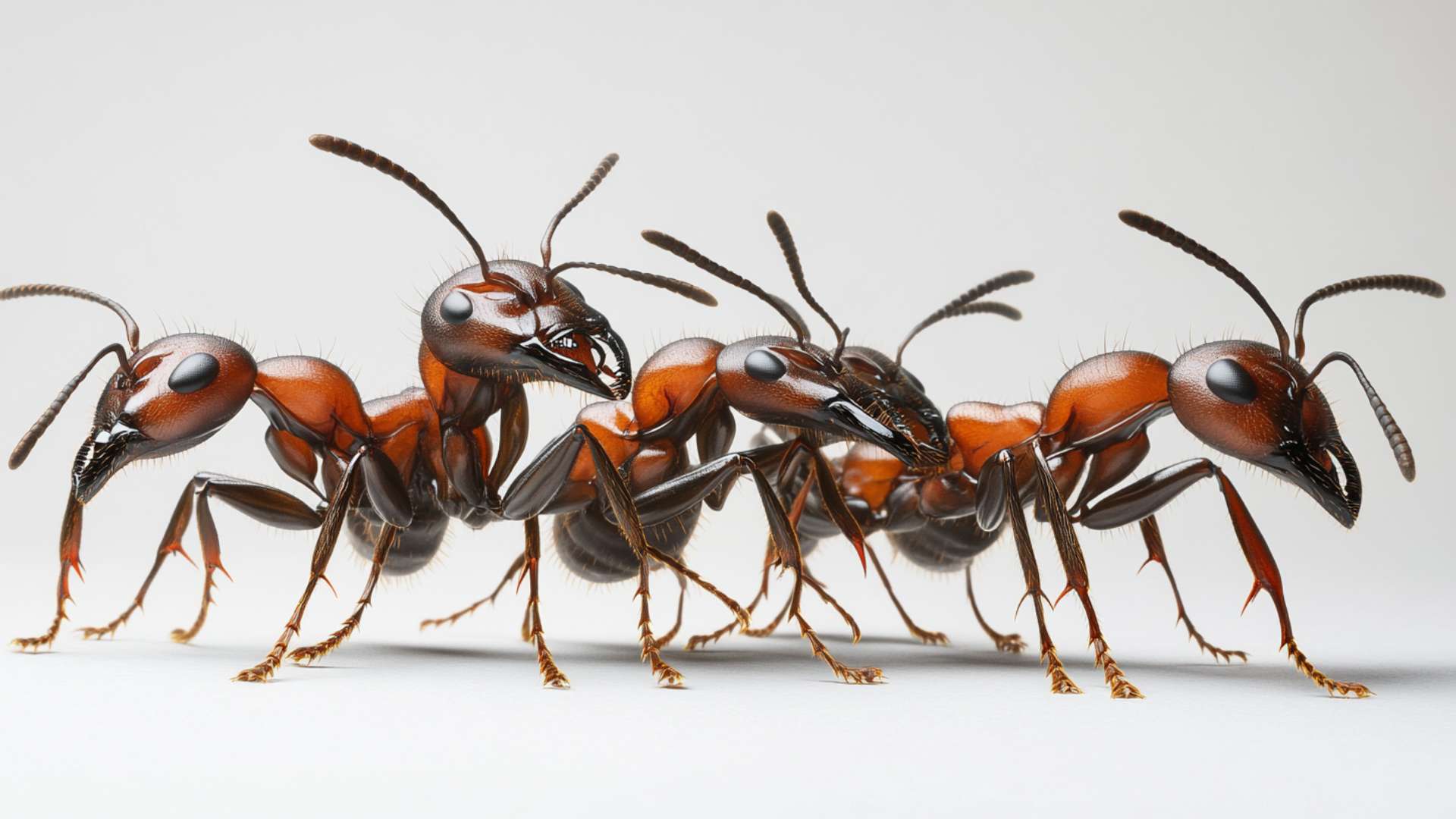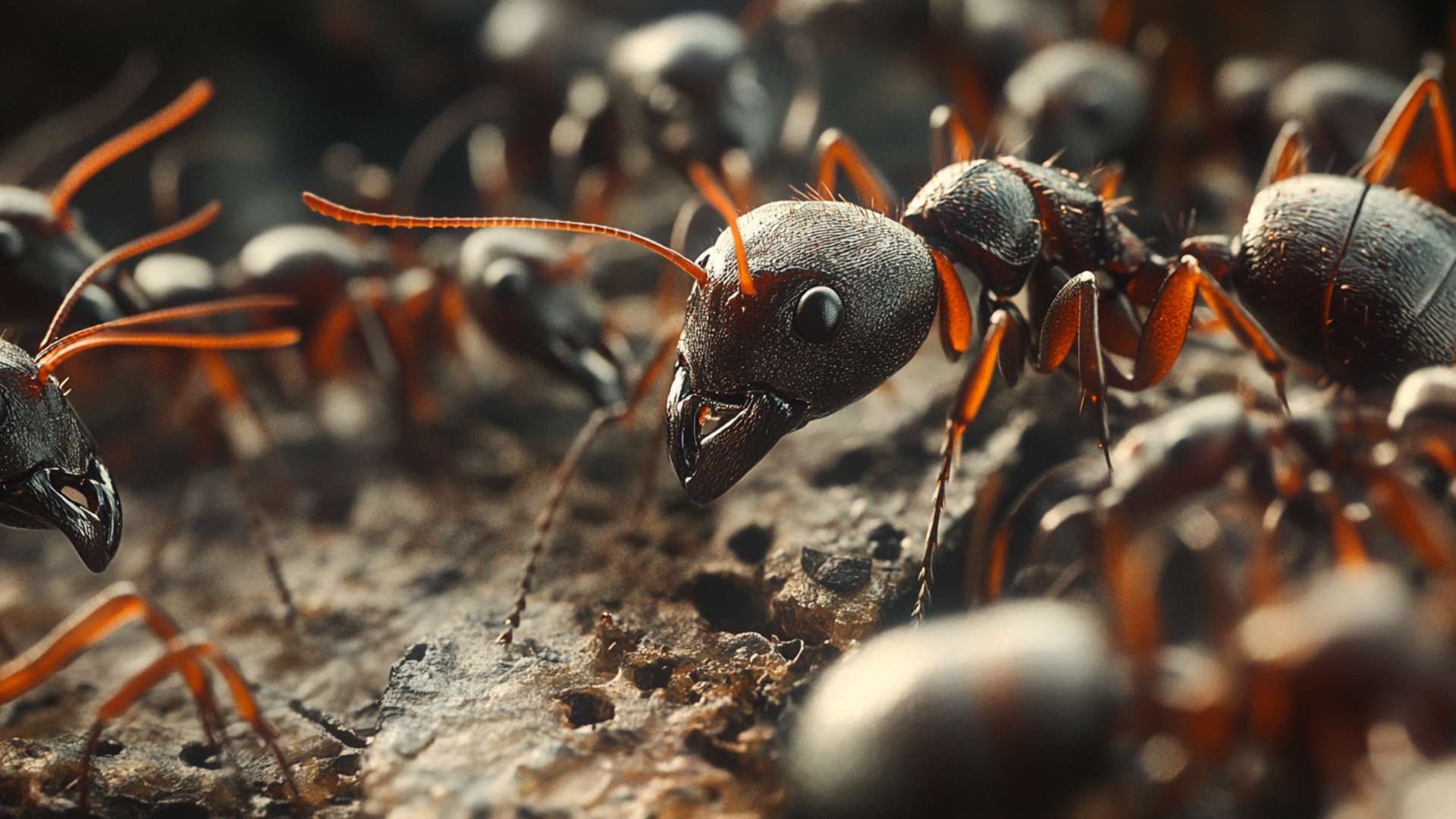Ants, those industrious little creatures scurrying around our backyards and parks, have long captivated our attention with their intricate social behavior. These tiny insects, with their hierarchical societies and cooperative efforts, have built magnificent colonies that can house millions of individuals. As we marvel at their complex network of tunnels and impressive division of labor, a curious question arises amidst our fascination: Do ants feel pain?
Brief overview of ants and their incredible social behavior

Ants belong to the order Hymenoptera, which also includes bees and wasps. With over 12,000 known species scattered across the globe, they have adapted to diverse habitats ranging from deserts to rainforests.
These remarkable insects organize themselves into colonies where each member plays a specific role to support the collective survival. The division of labor is astonishing; there are worker ants responsible for foraging food, tending to the young, and maintaining the nest’s infrastructure.
Meanwhile, soldier ants defend against threats while the queen’s sole purpose is reproduction. This sophisticated social system facilitates efficient insect farming activities within ant colonies.
Some species cultivate fungus as a primary food source while others “herd” aphids or scale insects for honeydew production. From trade-offs between risk-taking behaviors during resource gathering to communal care for developing larvae and pupae, ants display an exceptional level of cooperation that rivals even some human societies.
Intriguing question: Do ants feel pain?
Amidst this awe-inspiring lifestyle lies an intriguing query: do these tiny creatures experience discomfort or pain? While researchers have dedicated considerable efforts towards understanding insect pain perception in recent years, determining whether ants truly feel pain remains an ongoing scientific debate.
Numerous studies examining neural and behavioral evidence support pain and have provided substantial observations indicating that ants possess sensory information processing systems comparable to those found in animals capable of experiencing pain. However, reaching decisive proof has proven challenging.
Unlike humans, ants lack a centralized nervous system and internal organs such as the brain that we associate with pain perception. Yet, the absence of these features does not necessarily exclude the possibility of ant pain; it merely presents unique challenges for researchers seeking to unravel this mystery.
In our quest for understanding whether ants feel pain, we will delve into their anatomy and nervous systems, explore their responses to harmful stimuli, examine chemical signaling in their communication systems, review relevant studies conducted by researchers at Queen Mary University and other institutions, consider alternative perspectives on ant pain perception, and reflect on the ethical implications surrounding this topic more research. Through this exploration, we hope to shed light on an enigmatic aspect of these fascinating insects’ lives.
Understanding Ant Anatomy and Nervous System
Ants belong to the fascinating world of insects, with more than 12,000 known species buzzing around the globe. Their bodies are meticulously designed for efficiency and resilience. The exoskeleton, a hard outer covering made mainly of chitin, not only provides protection from potentially harmful stimuli but also serves as a supportive structure for their segmented body parts.
The exoskeleton is composed of several plates or sclerites that connect seamlessly, allowing ants to move with remarkable agility and flexibility. An ant’s body is divided into three main segments: the head, thorax, and abdomen.
The head houses essential sensory organs such as the antennae for detecting chemical signals in their environment. It also contains their powerful mandibles used for various tasks like cutting food, sugar water, or defending themselves against potential threats.
Connected to the thorax are six legs which enable ants to navigate their surroundings effortlessly. The abdomen is where critical internal organs such as the digestive system and reproductive organs are located.
Explanation of Ant Nervous System
While ants may not possess brains as complex as those found in humans or other mammals, they do exhibit a sophisticated nervous system that allows them to process information efficiently. Instead of a centralized brain, ants have small clusters of nerve cells called ganglia distributed throughout their bodies. These ganglia function like miniature brains that control different sections or regions connected by nerve cords.
The ganglia coordinate various bodily functions including movement, communication through chemical signaling using pheromones (more on this later), and responses to external stimuli. This decentralized nervous system grants ants an incredible ability to react swiftly and adaptively to changes in their environment without relying on a single central control unit.
Insect researchers have conducted numerous studies exploring how these nervous systems operate in different insect species like ants, cockroaches, and bees. Through various experiments, they have gained substantial evidence that these seemingly simple nervous systems are nonetheless capable of sophisticated processing and decision-making when it comes to responding to potentially harmful stimuli or distress.
Overall, understanding the ant anatomy and nervous system provides crucial insights into how these remarkable creatures interact with their surroundings and respond to different stimuli. While ants may lack the intricate brains of humans, their decentralized nervous system allows them to navigate their insect world with remarkable precision and effectiveness.
Defining Pain in the Context of Ants

When we talk about pain in animals, it’s important to understand that it’s not just about physical harm or injury. Pain is a complex sensory and emotional experience that involves both the mind and body.
While humans can express their discomfort through words like “ouch” or facial expressions, animals may rely on different signals to communicate their distress. The subjective experience of pain refers to how an individual perceives and reacts to harmful stimuli.
It involves more than just a simple reflex response; it encompasses an emotional and cognitive aspect as well. While we cannot fully comprehend what another organism experiences subjectively, growing evidence suggests that many animals have the capacity for pain.
Exploration of whether ants possess the necessary neural pathways to perceive pain
When it comes to ants, their tiny insect brains have sparked curiosity regarding their ability to feel pain. Research conducted at Queen Mary University and other institutions has provided intriguing insights into this question.
Ants possess a nervous system consisting of ganglia (clusters of nerve cells) connected by nerve cords that run along their body segments. These neural structures allow for communication between various parts of their bodies and control essential functions such as movement and sensory perception.
While ants lack complex brain structures like those found in mammals, there is evidence suggesting they possess some level of nociception – the ability to detect potentially harmful stimuli. Nociception acts as an early warning to an animal’s nervous system but does not guarantee conscious awareness or emotional response akin to what humans experience as pain.
Although studies indicate neural and behavioral evidence suggesting ants can sense noxious stimuli, whether they subjectively perceive this as painful remains uncertain. Further research is needed to explore the extent of ant sensitivity towards harmful stimuli and delve deeper into understanding insect pain perception.
Ant Responses to Harmful Stimuli
When it comes to facing threats, ants are not ones to back down easily. These tiny warriors have evolved an impressive array of defensive behaviors that showcase their resilience in the face of danger.
Whether it’s a predator lurking nearby or physical harm inflicted upon them, ants demonstrate their ability to protect themselves and their colony. One of the most well-known defensive mechanisms employed by ants is biting.
When threatened, certain species unleash their powerful mandibles with lightning speed, clamping down on anything that dares to disturb them. This aggressive response not only serves as a deterrent but also inflicts pain on potential adversaries.
Similarly, some ants possess stingers which they deploy as a means of defense against predators or intruders. The sting injects venom that causes discomfort and pain, discouraging any further aggression from other insects.
In addition to biting and stinging, some ants possess an extraordinary ability: spraying formic acid. When feeling threatened or provoked, these ingenious insects release a potent chemical cocktail that can cause irritation and even harm to potential attackers.
Formic acid is known for its pungent smell and corrosive properties which can induce pain upon contact with sensitive tissues and human brain. By employing this unique defense mechanism, ants have found an effective way to fend off threats and ensure the safety of their colony.
It is important to note that while these defensive behaviors serve an essential purpose in protecting ants from danger, they may also indicate at least some level of discomfort experienced by the individuals executing them. The reactions displayed by these remarkable creatures suggest a sensory response linked to experiencing pain—or at least something analogous—especially considering that these behaviors are reserved for situations where harm is imminent.
Peeking Into the Insect Brains: Highlighting How These Defensive Mechanisms May Indicate Some Level of Discomfort

While we cannot claim to fully understand the subjective experience of ants, researchers have dedicated their efforts to uncovering how these remarkable creatures perceive and respond to harmful stimuli. Evidence suggests that insects, including ants, possess the neural machinery necessary for processing sensory information and responding accordingly. Although conclusive research providing decisive proof is still forthcoming, studies conducted at institutions such as Queen Mary University have shed light on the intriguing question of whether or not ants feel pain.
Considering that many animals, including humans, display aversive reactions when exposed to painful stimuli, it would be logical to assume that ants could experience a similar type of common sense for distress. However, determining the precise nature of this experience in insects remains challenging due to the absence of certain criteria typically used by scientists to evaluate pain perception in animals.
Nevertheless, as we delve deeper into understanding ant behavior and physiology through rigorous scientific investigation, we may gain further insights into whether these fascinating creatures truly feel pain in a way analogous to our own experiences. Stay tuned for the next sections as we explore more scientific studies and alternative perspectives surrounding ant pain perception!
Ants have a highly sophisticated communication system based on chemical signaling, primarily through the use of pheromones. Pheromones act as crucial means for ants to convey information within their colonies and even across different ant species.
These chemical signals can transmit a wide range of messages, including alarm signals that warn other ants about potential harm or danger. Through the release of specific pheromones, ants can communicate information about threats such as predators or harmful environmental conditions.
For instance, when an ant is injured or killed, it emits an alarm pheromone that alerts other colony members to potential danger. The chemical signal triggers a response in nearby ants, urging them to be cautious and potentially engage in defensive behaviors.
Studies on Ant Behavior and Pain Perception
Scientific experiments have been conducted to explore whether ants display any pain responses or aversive reactions to noxious stimuli. These studies aim to shed light on the question of whether ants experience pain in a way similar to humans and other animals. Several experiments have shown that when exposed to harmful stimuli, like extreme heat or electric shocks, ants exhibit clear signs of distress and discomfort.
They may display altered behavior such as increased agitation, attempting to escape the stimuli, or even abandoning their usual activities temporarily. While these observations do not definitively prove that ants feel pain in the same way humans do, they strongly suggest that at least some insects experience discomfort and are capable of responding accordingly.
Alternative Perspectives on Ant Pain Perception
In contrast to studies suggesting pain perception in ants, there are alternative perspectives challenging the notion that insects feel pain at all. Some argue that since insects lack certain brain structures associated with experiencing pain in humans and vertebrates, it is unlikely they possess the capacity to feel pain.
Furthermore, proponents of these perspectives suggest that observed aversive reactions in ants may be solely reflexive responses to aversive stimuli, rather than indicative strong evidence of conscious experience. Exploring alternative explanations for observed ant behaviors, scientists have considered that these responses may be simply adaptive mechanisms designed to ensure survival.
For example, ants’ defensive behaviors might be instinctual and aimed at preserving the colony rather than motivated by subjective pain perception of mass suffering. However, ongoing research aims to further investigate and clarify this complex topic.
Ethical Implications and Considerations
The potential pain perception in ants raises important ethical concerns when it comes to animal welfare and conservation efforts. If insects indeed have the capacity to experience pain in some form, then subjecting them to unnecessary harm or exploiting them without consideration for their well-being becomes a matter of concern. Understanding ant pain is not just about individual insects but also has broader implications for conservation efforts.
Recognizing their capacity for experiencing discomfort could inspire us to develop more humane pest control methods that minimize unnecessary suffering. It could also prompt us to rethink our approach towards insect farming or invasive procedures on ants for scientific research purposes.
Conclusion
While the question of whether ants feel pain remains a subject of ongoing scientific inquiry, there is growing evidence suggesting that they possess mechanisms for perceiving and responding aversively to noxious or damaging stimuli themselves. The sophisticated chemical signaling system among ants highlights their ability to communicate information about potential harm or danger within their colonies. Considering the ethical implications surrounding ant pain perception can lead us towards a more compassionate approach when interacting with these incredible creatures and pave the way for better practices in animal welfare as a whole.
Dissuade Ants with D-Termination: Las Vegas’ Top Pest Control Choice!

If you’re confronted by ant problems, D-Termination is ready to assist. Our proficient team excels at discouraging ants, rejuvenating cleanliness, and preserving the integrity of your surroundings. Bid farewell to ants—opt for D-Termination for effective pest control today!
Reach out to us at 702-919-6310 or visit dtermination.com to schedule your ant control service and regain your space from these unwelcome pests.
Frequently Asked Questions:
Ants likely do not feel pain as humans do when squished.
Ants can sense injury or damage but may not feel pain as we do.
Ants can exhibit signs of distress when threatened, but it’s not the same as feeling fear or pain.
Insects are believed to have basic nervous systems, but their ability to feel pain and suffer is still a subject of scientific debate.








